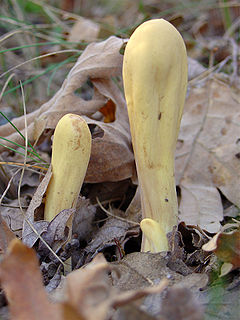| Revision as of 15:16, 24 November 2015 editJoJan (talk | contribs)Autopatrolled, Administrators172,812 edits editing← Previous edit | Revision as of 19:08, 25 November 2015 edit undoBgwhite (talk | contribs)Extended confirmed users547,151 edits fix bad isbn using AWB (11751)Next edit → | ||
| Line 21: | Line 21: | ||
| It grows during summer and autumn almost exclusively in beech forest on calcareous soil on litter and woodchips. | It grows during summer and autumn almost exclusively in beech forest on calcareous soil on litter and woodchips. | ||
| The mat and wrinkled ] has the shape of a club with a rounded top. Its length varies between 10 |
The mat and wrinkled ] has the shape of a club with a rounded top. Its length varies between 10 cm and 30 cm and its width between 1 cm and 5 cm. The skin is red brown to ocher red,sometimes cinnamon brown with a lilac tint, turning brown when damaged.The spongy flesh is white. The ] is pale yellow. it has a weak, but pleasant scent. | ||
| Through its appearance it could be mistaken for '']'', a species found in coniferous mountainous forests | Through its appearance it could be mistaken for '']'', a species found in coniferous mountainous forests | ||
| Line 27: | Line 27: | ||
| ==References== | ==References== | ||
| {{Reflist}} | {{Reflist}} | ||
| * Till R. Lohmeyer |
* {{cite book |first1=Till R. |last1=Lohmeyer |first2=Ute |last2=Künkele | last3=Ditter-Hilkens |first3=Inna |title=Mushrooms |publisher= Parragon Books |location Bath, UK |year= 2006 |isbn=9781405463997}} | ||
| * {{cite book |first= G. J. |last=Keizer |title=Paddenstoelen encyclopedie |year=1997| publisher=R & B |location=Lisse |isbn=9789039602393 |language=nl}} | |||
| * {{nl}} G.J. Keizer, Paddenstoelenencyclopedie; R&B; ISBN 90 396 0239 | |||
| ] | ] | ||
Revision as of 19:08, 25 November 2015
| Clavariadelphus pistillaris | |
|---|---|

| |
| Scientific classification | |
| Kingdom: | Fungi |
| Division: | Basidiomycota |
| Class: | Basidiomycetes |
| Subclass: | Agaricomycetidae |
| Order: | Gomphales |
| Family: | Gomphaceae |
| Genus: | Clavariadelphus |
| Species: | C. pistillaris |
| Binomial name | |
| Clavariadelphus pistillaris (L.) Donk | |
| Synonyms | |
|
Clavaria pistillaris L. | |
Clavariadelphus pistillaris is a rare species of mushroom of the family Gomphaceae native to Europe and North America.
It grows during summer and autumn almost exclusively in beech forest on calcareous soil on litter and woodchips.
The mat and wrinkled fruiting body has the shape of a club with a rounded top. Its length varies between 10 cm and 30 cm and its width between 1 cm and 5 cm. The skin is red brown to ocher red,sometimes cinnamon brown with a lilac tint, turning brown when damaged.The spongy flesh is white. The spore print is pale yellow. it has a weak, but pleasant scent.
Through its appearance it could be mistaken for Clavariadelphus truncatus, a species found in coniferous mountainous forests
References
- Lohmeyer, Till R.; Künkele, Ute; Ditter-Hilkens, Inna (2006). Mushrooms. Parragon Books. ISBN 9781405463997.
{{cite book}}: Text "location Bath, UK" ignored (help) - Keizer, G. J. (1997). Paddenstoelen encyclopedie (in Dutch). Lisse: R & B. ISBN 9789039602393.